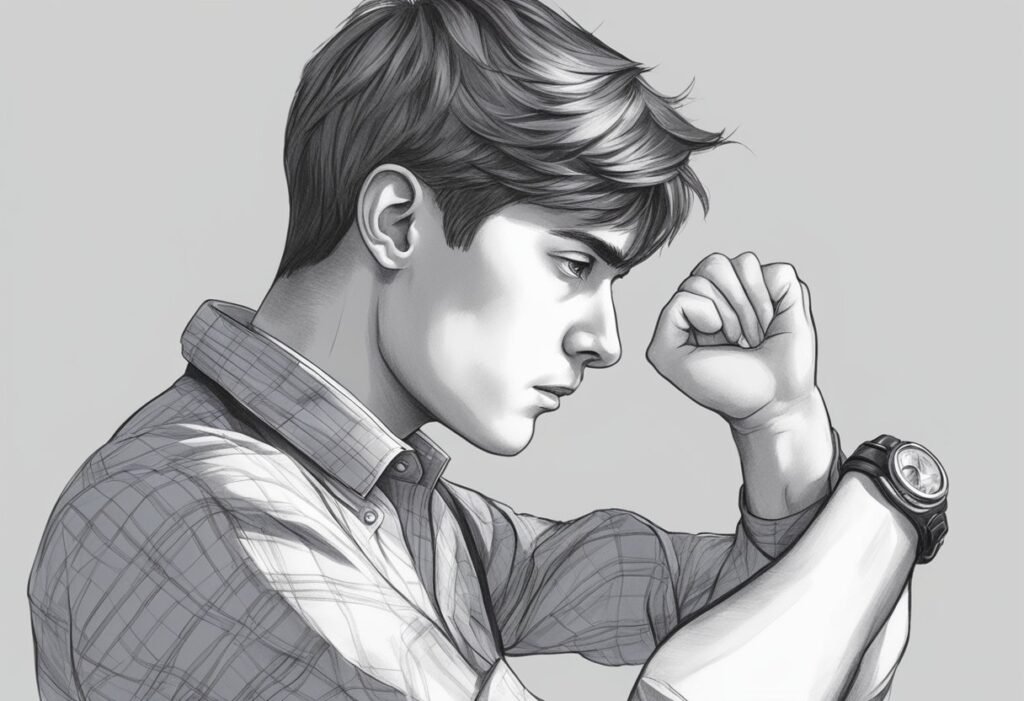Table of Contents
Have you ever wondered if someone is telling you the truth? People’s bodies often reveal what their words hide. When someone lies, their body language might not match what they’re saying. In this article, we will discuss 10 Body Language Signs They are Lying to You.

Spotting lies through body language involves looking for clusters of behaviors rather than single actions. According to experts, when evaluating if someone is being dishonest, it’s important to notice when their body language doesn’t agree with their spoken words. This mismatch is often the first clue to deception.
Subtle movements like touching the nose, stroking the chin, or pulling at the earlobe may indicate someone feels guilty about lying. These gestures happen because lying creates stress, and the body naturally responds to this discomfort. Learning to read these signals can help people identify dishonesty in everyday conversations.
Understanding Body Language and Deception

Deception leaves physical traces in our behavior that can be identified with careful observation. These nonverbal cues often contradict what someone says when they’re not being truthful.
The Psychology Behind Lies
When people lie, their bodies often reveal what their words conceal. This happens because lying creates cognitive stress in the brain. The psychological pressure of maintaining a falsehood while remembering the truth creates tension.
This tension manifests physically in several ways:
- Increased blinking or eye movement
- Touching the face or mouth (often unconsciously trying to “block” deceitful words)
- Changes in breathing patterns
- Microexpressions that flash across the face momentarily
Research shows that immediately after lying, definite physical changes occur. These reactions stem from the autonomic nervous system, which operates independently of conscious control.
The brain must work harder when fabricating information versus recalling actual memories. This extra effort often leads to noticeable delays in response time and inconsistencies between verbal and nonverbal communication.
Role of Body Language Experts
Body language experts are trained professionals who analyze nonverbal behaviors to detect deception. Their work combines elements of psychology, communication theory, and observational skills.
These specialists look for clusters of behaviors rather than isolated gestures. Accurate interpretation requires understanding baseline behaviors before identifying deviations.
Key areas body language experts focus on include:
- Facial expressions and microexpressions
- Posture changes when sensitive topics arise
- Hand and foot movements that indicate anxiety
- Voice tone and pace variations
Law enforcement agencies often employ body language experts during interrogations. Studies show that trained observers can significantly improve deception detection rates compared to untrained individuals.
These professionals emphasize that context matters greatly. Cultural differences, personal habits, and situational factors must all be considered when evaluating potential signs of deception.
Physical Indicators of Dishonesty

When someone lies, their body often reveals what their words try to hide. Physical signs of dishonesty appear across facial expressions and body movements, creating patterns that can help identify deceptive behavior.
Facial Expressions as Cues
The face is a primary canvas for detecting deception. When people lie, their facial expressions often don’t match their words. Watch for micro-expressions – brief flashes of true emotion that last only fractions of a second before being masked.
Dishonest individuals typically display these telling signs:
- Limited eye contact or excessive blinking
- Forced smiles that don’t reach the eyes (no crow’s feet)
- Asymmetrical expressions where only half the face moves naturally
- Lip pursing or mouth covering while speaking
Research shows that liars often touch their face more frequently, particularly around the mouth and nose areas. This self-soothing behavior stems from increased anxiety when fabricating information.
Gestures and Postures Signaling Deceit
A person’s body language can contradict their spoken claims. Deceptive individuals often display restricted body movements and appear stiff or unnaturally still.
Key physical indicators of dishonesty include:
- Defensive postures – crossed arms, turned away body
- Distancing behaviors – leaning back or creating barriers
- Fidgeting with objects or hands
- Incongruent nodding – head shaking “no” while saying “yes”
Hand movements become particularly revealing. People telling lies tend to keep their hands hidden or restrained. When visible, their gestures often appear mechanical rather than fluid and natural. Additionally, liars may unconsciously point their feet toward exits – a subconscious desire to escape the uncomfortable situation.
Vocal Cues and Verbal Patterns

When someone lies, their voice and speech patterns often change in subtle ways. These vocal shifts happen because lying creates stress and increased cognitive load in the brain.
Analyzing Tone of Voice
When people lie, their voice typically changes in pitch. Research shows that liars tend to speak with a higher pitched voice due to tension in the vocal cords. This change happens because of the stress and anxiety that comes with deception.
The tone may also sound strained or unnatural. Trained observers can detect these subtle vocal shifts even when the content of the speech seems convincing.
Volume changes are another indicator. Some liars speak more quietly to avoid drawing attention, while others might speak louder to appear more confident and mask their deception.
Voice modulation often becomes less natural during lying. The normal rhythmic patterns of speech may flatten or become exaggerated in ways that don’t match the emotional content of what’s being said.
Speech Hesitations and Inconsistencies
Liars frequently show distinct verbal patterns that differ from truthful speakers. They may use speech hesitations like “um,” “uh,” or unusual pauses while their brain works to construct false information.
Response latency (the time between question and answer) often increases. This happens because fabricating information requires more mental effort than recalling the truth.
Word choice can reveal deception too. Liars tend to:
- Use fewer personal pronouns (“I,” “me,” “my”)
- Speak more formally or use distancing language
- Include fewer specific details about time, place, or sensory experiences
Verbal inconsistencies are powerful indicators. When stories change with each retelling or contain logical contradictions, deception may be present. These verbal contexts provide crucial frameworks for interpreting potential lies.
Speech rate changes are common. Some liars speak more slowly because they’re carefully constructing their story, while others speed up to quickly move past dangerous topics.
Behavioral Tells and Micro-Expressions

When people lie, their bodies often reveal what their words conceal. These involuntary signals can appear as brief facial expressions or nervous behaviors that happen without conscious awareness.
Subtle Signs and Micro-Gestures
Micro-expressions are quick facial movements that last for just 1/15 to 1/25 of a second, making them difficult to catch without training. These fleeting expressions reveal genuine emotions that contradict what someone is saying.
Key micro-expressions to watch for:
- Fear: Raised eyebrows, widened eyes
- Contempt: One-sided mouth raise
- Disgust: Nose wrinkle, raised upper lip
- Anger: Lowered brows, tightened lips
These expressions serve as “hot spots” rather than definitive proof of deception. They indicate areas that require further questioning.
Context matters greatly when interpreting these cues. A person might display these expressions for reasons unrelated to lying, such as remembering something uncomfortable or reacting to an external stimulus.
Recognizing Fidgeting and Discomfort
Fidgeting behaviors often increase when someone is being deceptive. The body releases nervous energy through various self-soothing behaviors when under stress.
Common fidgeting tells include:
- Hand movements: Touching face, covering mouth
- Body positioning: Turning away, creating barriers
- Grooming gestures: Adjusting clothes, fixing hair
- Foot movement: Tapping, shifting weight
These behaviors stem from the body’s fight-or-flight response activating during deception. The brain focuses on creating the lie while simultaneously managing stress, making it difficult to control all physical responses.
Watch for clusters of behaviors rather than isolated incidents. Multiple tells occurring together provide stronger evidence of possible deception than any single cue alone.
Analyzing Eye Movements and Contact

Eyes reveal important clues when someone might be lying. Research shows specific patterns in eye behavior can indicate deception, though these signals must be considered alongside other behaviors rather than in isolation.
The Significance of Blinking
Blinking patterns often change when a person is being deceptive. People typically blink more rapidly when lying due to increased stress levels. This physiological response happens unconsciously as the brain works harder to create and maintain falsehoods.
However, some liars might do the opposite. They may blink less frequently while constructing a lie, followed by rapid blinking once the fabrication is complete.
Studies show that blink rates can increase up to 50% when someone is being dishonest. This occurs because lying requires more cognitive effort, which affects natural eye movements.
The baseline is important here. Observe the person’s normal blinking pattern first, then watch for significant deviations during questionable statements.
Eye Contact Patterns and Avoidance
Contrary to popular belief, liars don’t always avoid eye contact. Many deceptive people actually maintain stronger eye contact because they want to appear trustworthy or monitor if you believe them.
Research indicates that liars often make deliberate eye contact to convince others of their honesty. This intentional staring can feel uncomfortable or unnatural compared to the normal eye engagement patterns in honest conversation.
Watch for unusual fixation or complete avoidance. Both extremes—staring without breaking contact or refusing to meet eyes altogether—may signal deception.
The context matters too. Cultural differences and individual personality traits affect baseline eye contact behaviors, so consider these factors when assessing potential dishonesty.
Identifying Non-Verbal Signs of Lying

Detecting deception requires attention to specific non-verbal behaviors that often occur unconsciously when someone lies. These behaviors can contradict what the person is saying and must always be evaluated within the proper context rather than in isolation.
Non-Verbal Cues and Contradictions
When people lie, their body often reveals what their words conceal. Research shows that no single behavior definitively indicates deception, but clusters of behaviors can suggest dishonesty.
Common non-verbal signs that may indicate lying include:
- Reduced eye contact or excessive blinking
- Micro-facial expressions that flash briefly and contradict spoken words
- Increased touch behaviors like touching the face, neck, or mouth
- Rigid posture or unusual stillness compared to their baseline behavior
Body movements often become less natural when someone is lying. The person may appear stiff or exhibit delayed reactions due to the cognitive load of creating and maintaining a false narrative.
Body Language in Context
Non-verbal cues must always be interpreted within context rather than viewed in isolation. Studies indicate that baseline behavior varies significantly between individuals.
Cultural differences strongly influence non-verbal communication. What indicates deception in one culture may be normal behavior in another. For example, eye contact norms vary dramatically across cultures.
Stress and anxiety can mimic deception signals. Someone telling the truth while nervous might display the same behaviors as someone who is lying.
Look for clusters of behaviors that deviate from the person’s normal patterns. The most reliable approach is to observe changes from their typical behavior rather than relying on universal “lying signals.”
Pay special attention to contradictions between verbal and non-verbal communication. These inconsistencies often reveal deception more reliably than any single behavior alone.
Practical Techniques for Detecting Lies

Identifying deception requires specific observation skills and an understanding of both verbal and nonverbal cues. While no single technique works perfectly every time, certain methods can significantly improve your ability to spot potential lies.
Applying Observation Skills
Look for clusters of behaviors rather than single signs. When trying to detect lies, watch for inconsistencies between what someone says and their body language.
Pay attention to:
- Baseline behavior: Observe how a person normally acts before looking for changes
- Microexpressions: Brief facial expressions that last 1/25 of a second and often reveal true feelings
- Body movement shifts: Sudden changes in posture or increased fidgeting
- Voice changes: Listen for pitch variations, speech hesitations, or talking speed alterations
Hand movements may become more restricted when someone is lying. Research shows that liars often touch their face, neck, or mouth more frequently during deception.
Lie Detection and Its Limitations
Even experts correctly identify lies only about 54% of the time, slightly better than chance. No foolproof “human lie detector” exists.
Common limitations include:
- Individual differences in how people express deception
- Cultural variations in nonverbal communication
- High-stakes vs. low-stakes lying behaviors differ significantly
- Skilled liars may not display typical deception cues
The context matters tremendously. Someone might show stress signs not because they’re lying but because they feel accused or nervous about being evaluated.
Practiced liars can control many behavioral signs commonly associated with deception. The most reliable approach combines careful observation with strategic questioning techniques.



